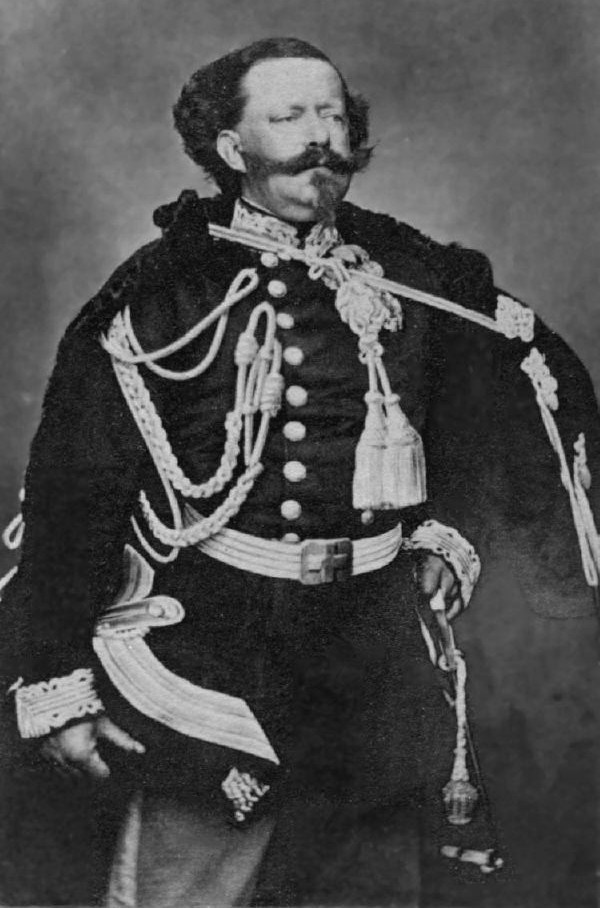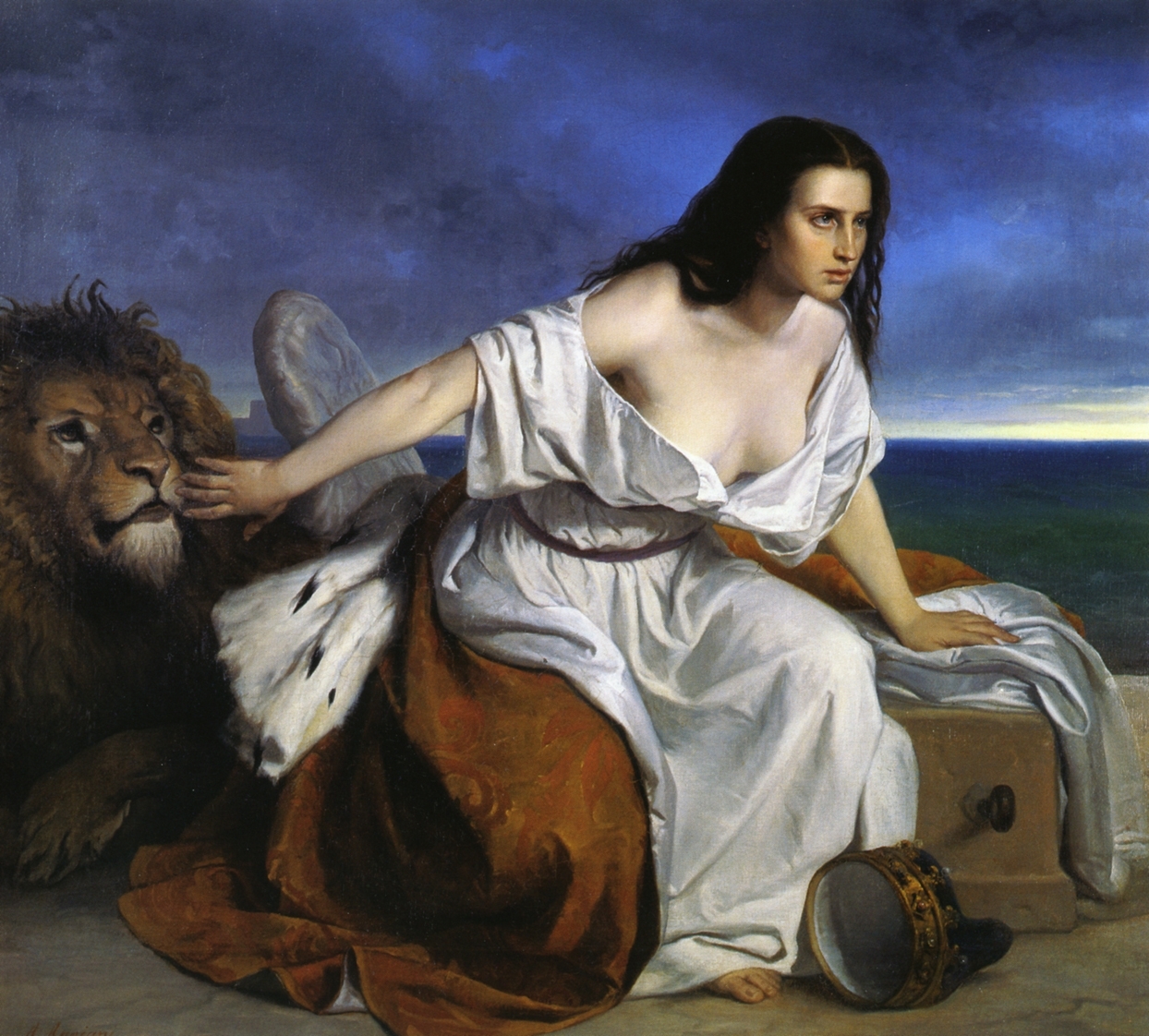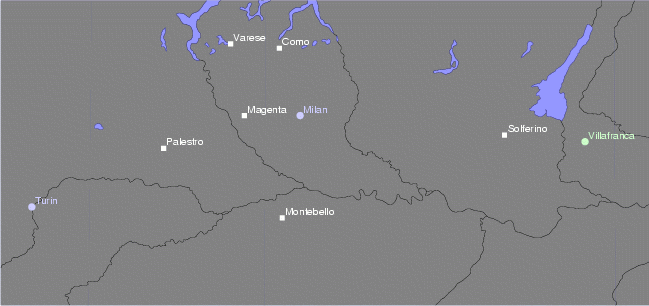|
Ettore Bertolè-Viale
Ettore Bertolè-Viale (Genoa, 25 November 1829 – Turin, 13 November 1892 ) was an Italian general and politician. He was senator of the Kingdom of Italy and Minister of War in the first, second and third Menabrea governments, the eighth Depretis government and the first and second Crispi governments. Military career Born into a family with military traditions, he attended the military academy in Turin, graduating in 1844. Appointed Second Lieutenant at eighteen, the following year he became Lieutenant and was enrolled in the 13th infantry regiment, Savona brigade with which he took part in the First Italian War of Independence. After the end of the war, he resumed his studies and became a General Staff officer. He took part in the Crimean War with the rank of Captain in command of the 2nd provisional brigade of the General Staff and fought at the Battle of the Chernaya. In 1859 he took part in the Second Italian War of Independence with the rank of staff captain, fighting u ... [...More Info...] [...Related Items...] OR: [Wikipedia] [Google] [Baidu] |
Minister Of War (Italy)
The Minister of War of Italy ( it, Ministri della guerra del Regno d'Italia), was the minister responsible for the Ministry of War and the Royal Italian Army. The position was abolished with the creation of the position for Minister of Defence (Italy), Minister of Defence. The first Minister of War was Manfredo Fanti, a General of the Royal Italian Army, while the last one was Cipriano Facchinetti, a member of the Italian Republican Party. The longest serving minister was the Italian dictator, Benito Mussolini, of the National Fascist Party. List of Ministers Kingdom of Italy ; Parties * ** ** * ** ** ** ** ** * ** * ** ** ** ;Coalitions * ** ** ** * ** * ** * ** Republic of Italy ;Parties * ;Coalitions * See also * Italian Minister of the Air Force * Italian Minister of the Navy References {{Council of Ministers of Italy Lists of government ministers of Italy, War ... [...More Info...] [...Related Items...] OR: [Wikipedia] [Google] [Baidu] |
Crimean War
The Crimean War, , was fought from October 1853 to February 1856 between Russia and an ultimately victorious alliance of the Ottoman Empire, France, the United Kingdom and Piedmont-Sardinia. Geopolitical causes of the war included the decline of the Ottoman Empire, the expansion of the Russian Empire in the preceding Russo-Turkish Wars, and the British and French preference to preserve the Ottoman Empire to maintain the balance of power in the Concert of Europe. The flashpoint was a disagreement over the rights of Christian minorities in Palestine, then part of the Ottoman Empire, with the French promoting the rights of Roman Catholics, and Russia promoting those of the Eastern Orthodox Church. The churches worked out their differences with the Ottomans and came to an agreement, but both the French Emperor Napoleon III and the Russian Tsar Nicholas I refused to back down. Nicholas issued an ultimatum that demanded the Orthodox subjects of the Ottoman Empire be placed ... [...More Info...] [...Related Items...] OR: [Wikipedia] [Google] [Baidu] |
Battle Of Dogali
The Battle of Dogali was fought on 26 January 1887 between Italy and Ethiopia in Dogali near Massawa, in present-day Eritrea. History The Italians, after their unification in 1861, wanted to establish a colonial empire to cement their great power status. Their occupation of coastal Eritrea brought Italian interests into direct conflict with those of Ethiopia (Abyssinia). As soon as the Italians considered they were strong enough to advance into Abyssinia, they seized the villages of Ua-à and Zula along with the town of Sahati, in modern-day Eritrea and erected a small redoubt on the heights commanding the water supply for the caravans. Ras Alula Engida the governor under Emperor Yohannes IV had at the time left Asmara, his headquarters, for the Basen country, in order to punish the Dervishes for raiding the Dembala provinces. On hearing the news of the Italian advance, he returned to Asmara and informed the Italian officials that they were violating the treaty between Abyssin ... [...More Info...] [...Related Items...] OR: [Wikipedia] [Google] [Baidu] |
Agostino Depretis
Agostino Depretis (31 January 181329 July 1887) was an Italian statesman and politician. He served as Prime Minister of Italy for several stretches between 1876 and 1887, and was leader of the Historical Left parliamentary group for more than a decade. He is the fourth-longest serving Prime Minister in Italian history, after Benito Mussolini, Giovanni Giolitti and Silvio Berlusconi. Depretis is widely considered one of the most powerful and important politicians in Italian history. He was a master in the political art of ''Trasformismo'', the method of making a flexible, centrist coalition of government which isolated the extremes of the left and the right in Italian politics after the unification.Killinger, The history of Italy', p. 127–28 Early life and Italian Unification Depretis was born at Bressana Bottarone, near Stradella, which at the time was a province of the French Empire of Napoleon and now is in the province of Pavia, Lombardy. After Napoleon's defeat and restor ... [...More Info...] [...Related Items...] OR: [Wikipedia] [Google] [Baidu] |
Umberto I Of Italy
Umberto I ( it, Umberto Rainerio Carlo Emanuele Giovanni Maria Ferdinando Eugenio di Savoia; 14 March 1844 – 29 July 1900) was King of Italy from 9 January 1878 until his assassination on 29 July 1900. Umberto's reign saw Italy attempt colonial expansion into the Horn of Africa, successfully gaining Eritrea and Somalia despite being defeated by Abyssinia at the Battle of Adwa in 1896. In 1882, he approved the Triple Alliance with the German Empire and Austria-Hungary. He was deeply loathed in leftist circles for his conservatism and support of the Bava Beccaris massacre in Milan. He was especially hated by anarchists, who attempted to assassinate him during the first year of his reign. He was killed by another anarchist, Gaetano Bresci, two years after the Bava Beccaris massacre. Youth The son of Victor Emmanuel II and Archduchess Adelaide of Austria, Umberto was born in Turin, which was then capital of The Kingdom of Piedmont-Sardinia, on 14 March 1844, his father's 24 ... [...More Info...] [...Related Items...] OR: [Wikipedia] [Google] [Baidu] |
Victor Emmanuel II
Victor Emmanuel II ( it, Vittorio Emanuele II; full name: ''Vittorio Emanuele Maria Alberto Eugenio Ferdinando Tommaso di Savoia''; 14 March 1820 – 9 January 1878) was King of Sardinia from 1849 until 17 March 1861, when he assumed the title of King of Italy and became the first king of an independent, united Italy since the 6th century, a title he held until his death in 1878. Borrowing from the old Latin title ''Pater Patriae'' of the Roman emperors, the Italians gave him the epithet of '' Father of the Fatherland'' ( it, Padre della Patria). Born in Turin as the eldest son of Charles Albert, Prince of Carignano, and Maria Theresa of Austria, he fought in the First Italian War of Independence (1848–1849) before being made King of Piedmont-Sardinia following his father's abdication. He appointed Camillo Benso, Count of Cavour, as his Prime Minister, and he consolidated his position by suppressing the republican left. In 1855, he sent an expeditionary corps to side with ... [...More Info...] [...Related Items...] OR: [Wikipedia] [Google] [Baidu] |
Capture Of Rome
The Capture of Rome ( it, Presa di Roma) on 20 September 1870 was the final event of the unification of Italy (''Risorgimento''), marking both the final defeat of the Papal States under Pope Pius IX and the unification of the Italian Peninsula (except San Marino) under the Kingdom of Italy. The capture of Rome by the Italian Army brought an end to the Papal States, which had existed since 756, and the temporal power of the Holy See, and led to the establishment of Rome as the capital of unified Italy. It is today widely commemorated throughout Italy, with the ''Via XX Settembre'' street name in a considerable number of localities. Background During the Second Italian War of Independence, much of the Papal States had been conquered by the Kingdom of Sardinia under King Victor Emmanuel II, who became King of Italy#Independent Kingdom of Italy, House of Savoy (1861–1946), King of Italy upon the proclamation of the Kingdom of Italy on 17 March 1861. The new state still had not i ... [...More Info...] [...Related Items...] OR: [Wikipedia] [Google] [Baidu] |
Crescentino
Crescentino is a ''comune'' (municipality) in the Province of Vercelli in the Italy, Italian region Piedmont, located about northeast of Turin and about southwest of Vercelli. Crescentino borders the following municipalities: Brusasco, Fontanetto Po, Lamporo, Livorno Ferraris, Moncestino, Saluggia, Verolengo, and Verrua Savoia. Twin towns — sister cities Crescentino is town twinning, twinned with: * San Giorgio Albanese, Italy * Gmina Łososina Dolna, Poland People * Luigi Arditi (1822–1903), violinist and composer * Bartolomeo Caravoglia (active 1660–1673), painter of the Baroque period * Fiorenza Cossotto (born 1935), operatic mezzo-soprano * Domenico Serra, (1899–1965), stage and film actor References External linksOfficial website Crescentino, {{Vercelli-geo-stub ... [...More Info...] [...Related Items...] OR: [Wikipedia] [Google] [Baidu] |
Third Italian War Of Independence
The Third Italian War of Independence ( it, Terza Guerra d'Indipendenza Italiana) was a war between the Kingdom of Italy and the Austrian Empire fought between June and August 1866. The conflict paralleled the Austro-Prussian War and resulted in Austria conceding the region of Venetia (present-day Veneto, Friuli and the city of Mantua, the last remnant of the ''Quadrilatero'') to France, which were later annexed by Italy after a plebiscite. Italy's acquisition of this wealthy and populous territory represented a major step in the Unification of Italy. Background Victor Emmanuel II of Savoy had been proclaimed King of Italy on 17 March 1861 but did not control Venetia or the much-reduced Papal States. The situation of the , a later Italian term for part of the country under foreign domination that literally meaning ''unredeemed'', was an unceasing source of tension in the domestic politics of the new kingdom and a cornerstone of its foreign policy. The first attempt to seize ... [...More Info...] [...Related Items...] OR: [Wikipedia] [Google] [Baidu] |
Armistice Of Villafranca
The Second Italian War of Independence, also called the Franco-Austrian War, the Austro-Sardinian War or Italian War of 1859 ( it, Seconda guerra d'indipendenza italiana; french: Campagne d'Italie), was fought by the Second French Empire and the Savoyard Kingdom of Sardinia against the Austrian Empire in 1859 and played a crucial part in the process of Italian Unification. A year prior to the war, in the Plombières Agreement, France agreed to support Sardinia's efforts to expel Austria from Italy in return for territorial compensation in the form of the Duchy of Savoy and the County of Nice. The two states signed a military alliance in January 1859. Sardinia mobilised its army on 9 March 1859, and Austria mobilized on 9 April. On 23 April, Austria delivered an ultimatum to Sardinia demanding its demobilization. Upon Sardinia's refusal, the war began on 26 April. Austria invaded Sardinia three days later, and France declared war on Austria on 3 May. The Austrian invasion was ... [...More Info...] [...Related Items...] OR: [Wikipedia] [Google] [Baidu] |
Battle Of Magenta
The Battle of Magenta was fought on 4 June 1859 during the Second Italian War of Independence, resulting in a French-Sardinian victory under Napoleon III against the Austrians under Marshal Ferencz Gyulai. It took place near the town of Magenta in the Kingdom of Lombardy–Venetia, a crown land of the Austrian Empire, on 4 June 1859. Napoleon III's army crossed the Ticino River and outflanked the Austrian right forcing the Austrian army under Gyulai to retreat. The confined nature of the country, a vast spread of orchards cut up by streams and irrigation canals, precluded elaborate manoeuvre. The Austrians turned every house into a miniature fortress. The brunt of the fighting was borne by 5,000 grenadiers of the French Imperial Guard, still mostly in their First Empire style of uniforms. The battle of Magenta was not a particularly large battle, but it was a decisive victory for the Franco-Sardinian alliance. Patrice de MacMahon was created Duc de Magenta for his role in this ba ... [...More Info...] [...Related Items...] OR: [Wikipedia] [Google] [Baidu] |
Battle Of Palestro
The Battle of Palestro was fought on 30–31 May 1859 between the Austrian Empire and the combined forces of the Kingdom of Sardinia-Piedmont and France. The Franco-Piedmontese forces were victorious. It was fought just south to Palestro, a town in what is now the province of Pavia in northern Italy. It was believed that the Battle of Palestro was the last European battle in which a European Monarch rode into battle, that being King Victor Emmanuel II, who directly entered the fray with the Austrians. Background Ferenc Gyulay, anticipating an advance on Milan, but unsure of the route, had placed his VIII and IX Korps south of the Po river from Pavia to Piacenza. Gyulay had assigned Zobel's VII Korps responsibility for the Sesia sector. However, on 30 May, four Piedmontese divisions had established a bridgehead across the Sesia, occupying Palestro, Vinzaglio, and Confienza. This included Enrico Cialdini's 4th Division, Giovanni Durando's 1st Division, and Mollard's 3rd Division. ... [...More Info...] [...Related Items...] OR: [Wikipedia] [Google] [Baidu] |





.jpg)


_-_litografia_-_1860.jpg)